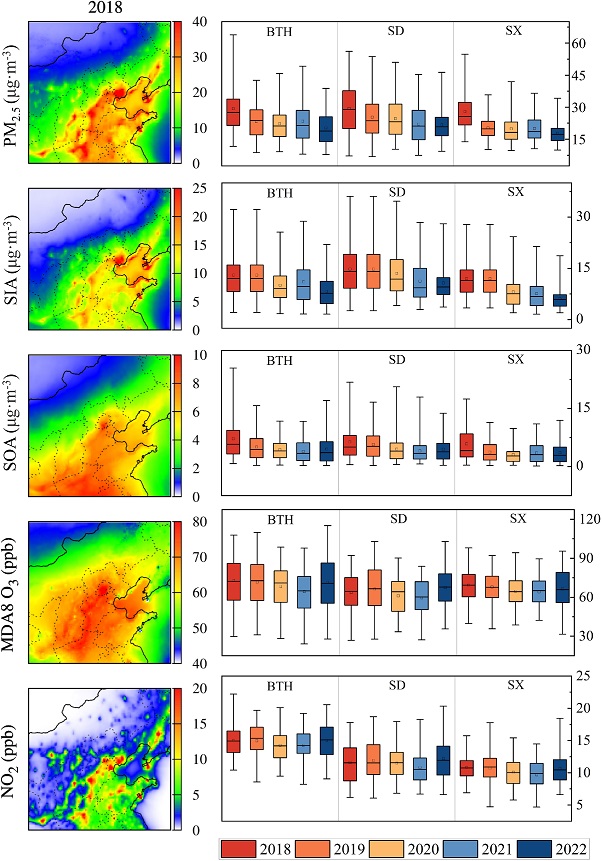Like most countries, China has had its problems with air pollution. However, over the last decade, a series of successful measures implemented by the Chinese government have resulted in an impressive improvement in air quality.
Nonetheless, despite this improvement, severe air pollution events still occur, and scientists already know that contributions from secondary air pollutants (pollutants formed in the lower atmosphere by chemical reactions), such as ozone and secondary organic aerosol (SOA), have notably increased.
Yet, our understanding of how secondary air pollutants form and how they vary in response to changes in the weather and emissions of their precursor substances (i.e., primary air pollutants), remains limited. This is a key knowledge gap to address, particularly in areas with dense populations, such as the North China Plain (NCP) region, because being able to prevent or mitigate air pollution has a direct positive impact on human health and other aspects of our everyday lives, such as traffic safety.
Motivated by these aspects, a cross-institutional team of scientists in China recently designed and carried out a study to deepen our understanding of the response of secondary air pollutants to variations in meteorology and primary anthropogenic emissions. Their focus was on the warm season (May to September) in the NCP region from 2018 to 2022, chosen to reflect a phase of new measures brought in by the Chinese government at the beginning of this period.
The team employed a widely used and highly regarded model called CMAQ (Community Multiscale Air Quality Model) to estimate the changes in concentrations of secondary pollutants in response to variations in meteorological conditions and primary emissions. The findings have recently been published in Atmospheric and Oceanic Science Letters.
“Crucially, we found that, among the secondary air pollutants we modelled, reduced primary emissions contributed a staggering 96% to the decrease in fine particles, while the fluctuations in ozone levels were mainly caused by changes in meteorological conditions”, explains Prof. Hongliang Zhang, one of the corresponding authors of the study.
There were also clear findings regarding other secondary pollutants. For instance, reductions in sulphate and ammonium could largely be attributed to falls in emissions, while reductions in nitrate were more sensitive to changes in the weather. The contributions of meteorological and emission changes to the overall reduction in SOA were found to be similar, in which the response of anthropogenic SOA to emission reductions was more obvious, while the change in biogenic SOA was more influenced by meteorological conditions.
Although the study highlights evident roles played by the weather with respect to certain secondary air pollutants, the take-home message, says Prof. Zhang, is “the clear importance of controlling anthropogenic emissions to mitigate secondary pollution in the NCP region during summer”.
The work, however, does not stop here. Although, as mentioned, CMAQ is a well-established model, there are always methodological developments that can be made to improve the robustness and confidence in results. For instance, there are some exciting new technologies for identifying pollution sources that could be integrated, and innovative meteorological and chemical mechanisms ready to be introduced.
“Ultimately”, concludes Prof. Zhang, “we want to quantify the impacts of emissions and meteorology on secondary pollutants even more accurately, so as to achieve evermore precise formulations of collaborative control strategies for mitigating concentrations of what we know in the field to be the two most critical secondary air pollutants—fine particulates and ozone”.

Figure: Spatial distribution of predicted pollutants in 2018 and the average values from 2018 to 2022 in different regions.
Link:
https://doi.org/10.1016/j.aosl.2024.100495
Citation:
Yueqi Gao, Siyu Wang, Zhaolei Zhang, Wenxuan Yu, Shuai Wang, Shengqiang Zhu, Peng Wang, Yan Li, Yele Sun, Hongliang Zhang, 2024. Response of warm season secondary pollutants to emissions and meteorology in the North China Plain region during 2018–2022. Atmospheric and Oceanic Science Letters, https://doi.org/10.1016/j.aosl.2024.100495.
|